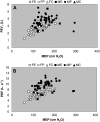Relationship between ventilatory function and age in master athletes and a sedentary reference population
- PMID: 22544616
- PMCID: PMC3636401
- DOI: 10.1007/s11357-012-9409-7
Relationship between ventilatory function and age in master athletes and a sedentary reference population
Abstract
Ageing is accompanied with a decline in respiratory function. It is hypothesised that this may be attenuated by high physical activity levels. We performed spirometry in master athletes (71 women; 84 men; 35-86 years) and sedentary people (39 women; 45 men; 24-82 years), and calculated the predicted lung age (PLA). The negative associations of age with forced expiratory volume in 1 s (FEV1; 34 mL·year(-1)) and other ventilatory parameters were similar in controls and master athletes. FEV1pred was 9 % higher (P < 0.005) and PLA 15 % lower (P = 0.013) in athletes than controls. There were no significant differences between endurance and power athletes and sedentary people in maximal inspiratory and expiratory pressure. Neither age-graded performance nor weekly training hours were significantly related to lung age. Life-long exercise does not appear to attenuate the age-related decrease in ventilatory function. The better respiratory function in master athletes than age-matched sedentary people might be due to self-selection and attrition bias.
Figures







References
Publication types
MeSH terms
LinkOut - more resources
Full Text Sources
Medical
